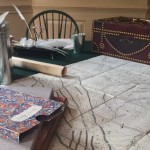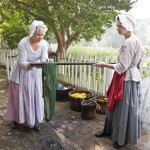On most days, my job with Colonial Williamsburg means putting on 18th-century attire and heading into our fair city for a busy day of demonstrating my trade, answering lots of questions, and having in-depth conversation with inquisitive guests…but not today. But today, I am taking a walk in the forest.
It’s quiet here—peaceful with just the sounds of birds and wind in the leaves. I tilt my head back to look up at the canopy and am reminded that countless generations before me have taken this same walk for this same reason. I’m one of two full-time basketmakers here at CW, and just as it has been done for ages, every basket we make begins with the careful selection of white oak trees.
Baskets are one of the oldest and most ubiquitous tools made by the human race. Unlike today, where they are often used as decorative items and making them is usually just a hobby, here in the Revolutionary City (and in truth for most of history), baskets were a necessity. In the 18th century, most Virginians were living on farms. And making utilitarian baskets for their own needs would have been a life skill they learned as children. White oak is the only tree that works in this part of the country. It will split thinly, stay flexible, and make into a sturdy and inexpensive container that can be used for a million different chores. It’s so practical, that many rural families continued to be make them until quite recently. The skill was often handed down from one generation to the next. In fact, the basketmaking program here started more than 50 years ago with Lucy and Cody Cook, a couple whose family had been making baskets since the 1700s here in Virginia. The knowledge they shared was passed down and eventually made its way to me!
Many of our guests express a certain amount of surprise when they discover we make our own weaving material. “Where do you buy your reed?” “Who splits your material for you?” “YOU don’t actually do that…do you?” All logical questions we get asked many times a day. Our mission in the Department of Historic Trades & Skills is to preserve every aspect of these old crafts, and when it comes to white oak basketmaking, turning the tree into the material is where we invest the majority of our time and work. So, no… we don’t buy or use reed, and yes… we actually turn trees into weaving splits all on our own.
Now, back to my walk through the woods, searching for trees. I quickly realize we could be here a while; we’re picky about our wood. It’s important to point out that just because it’s white oak, it doesn’t mean it can be used to make a basket.
So just what are we looking for? We need a tall smaller tree usually found deep in the forest (a six- to eight-inch diameter trunk is best). Oh, and we only use the trunk from the ground to the first major branch or blemish. Branches don’t work, because they don’t grow straight, and we need a good straight grain. If there are knots, twists, bug damage, etc., then we avoid that tree.
We’re often asked how we cut the trees, and I will confess… we use a chainsaw (to save time). We also bring them back to our worksite at CW in a pickup truck (seeing as police frown on using the oxen on the interstate). Once we get back here, we process the logs into material using the tools and techniques of the 18th century. First, a large wooden maul, an axe, and a set of wedges are used to split the log to the desired width. Then, a sharp knife and our hands are used to split the wood to the desired thinness. Splitting is done green. The wood is allowed to dry for a day or so and then it can be woven into baskets without the need to soak the material. The baskets we make today are used throughout CW. I daresay you’ll find our work around just about every corner with any extras going to the Prentis Store here in town for sale.
I have to be honest and say that there is a certain amount of satisfaction I feel when I look at one of my finished baskets. It’s a unique pride at having been a part of every step in its creation—from tree to basket. This aspect of my job that I enjoy the most however is also the part that gives me the most unrest. That’s because sometimes finding white oak is easier said than done. When we need material, we can’t just take a quick trip to the craft store or the lumberyard. The trees we want are best found deep in the canopy, so we need good forested acreage. While we have a couple of places we are cutting white oak from at the moment, it’s never a good idea to put all your eggs in one basket (just a bit of basket humor for you). Finding new places to go and look for trees can be challenging, and we’re always worried about our wood supply.
So, we need your help! We want to continue to make baskets and educate people about their importance. If you couldn’t tell already, I get pretty excited about my job. I love these white oak baskets and sharing their history with our guests, but without a reliable resource that isn’t possible. Do you have some forested acreage? When’s the last time you took a walk in your woods? Perhaps it’s time to take a stroll… and this time maybe look around with the eyes of a basketmaker. If you see lots of white oak, take a closer look and see if your imagination can’t transform them into baskets. Then perhaps be so kind as to consider reaching out to us and allowing us to make that transformation a reality. We put together a short video to illustrate exactly what we’re looking for and how the wood will be used!
GUEST BLOGGER: KRISTY ENGEL
Kristy Engel is a journeyman basketmaker at Colonial Williamsburg. In 1998 she graduated from West Virginia Wesleyan College with a BA in History and a minor in both English and Anthropology. What does one do with that degree?! Why get a job at CW of course! She began her career here fresh out of college and 17+ years later is still loving it.
She has held a variety of positions, but nine years ago she became a basketmaker and finally found her real niche. If you visit Colonial Williamsburg you might find her busy at work with her fellow journeyman basketmaker (and wonderful teacher) Terry Thon, and the shop master Mr. Thomas Grey Esq. (colonial cat extraordinaire).



What a nice article!! Sadly the management of Colonial Williamsburg has decided this craft is no longer necessary to preserve and has eliminated it and terminated the two employees, including the one who wrote this article!! Shame on you Colonial Williamsburg!!! For an organization dedicated to preserving historic crafts and trades this is, in effect, killing a dying art!!!
Thankfully at least one of the basketweavers is pursuing her art independently and will make baskets available for sale when ready. Not letting this trade die despite CW’s vest efforts! What a loss for the Foundatiom. I wonder how much their many VP’s are making?
Linda says
Our woods are at least an hour away from Williamsburg, but you’d be welcome to look and see if anything is suitable. Be prepared for poison ivy, though. It doesn’t seem to bother the deer or foxes.
Thank-you for your reply! We have had a wonderful response for our plea for white oak. This is actually a project that we set up to work for us for years to come-so though we do not need your woods right now, we would like to keep them in mind for the future. Many thanks!!
Terry Thon
Basket-maker
Basketmakers@cwf.org
Wow- you harvest and make your own supplies! I am in awe. 21st c Americans who biy most everything from Communist China don’t understand the time and effort required by handicrafts (I process fleece yarn by scouring and spinning it, but that’s a cinch compared to what you do).
. There is white oak by me, but I’m just outside Savannah, GA. That would be a long trip for the oxen.